
Traditional shutters in the old town of Arles along the Rhone River.
On 19 May 2018, the three of us—Annie, Carol and myself—left quiet little Lapradelle behind and began the drive east toward Arles. The mountains gradually gave way to wider, easier roads, and somewhere along the plains we made a detour to wander the magnificent walled citadel of Carcassonne, stretching our legs along its medieval ramparts before carrying on.
By the time we approached Arles, Annie’s driving skills and confidence had grown with the widening roads and bigger towns. Amazingly, we found a park right outside our Airbnb apartment and left the car there the whole time, convinced we’d hit the parking jackpot. Almost every other car in the street sported scrapes and dents, and as ours was a hire car, we decided not to risk it.
For the next two nights we were ready to soak up the beautiful ambience of Arles—its medieval streets, delightful museums and great views of the Rhône.

The evening view from our Airbnb in Arles.
From our arrival in Arles the night before, we had been immersed in a rich blend of charming 18th-century laneway architecture, massive and mind-boggling Roman remains, and marvellous museums. My ICOM (International Council of Museums) pass had been running hot as I flashed it for free entry to the Musée Réattu, which cleverly blended artworks from the past and present within its historic rooms; and the Musée Départemental Arles Antique, where the highlight for me was the enormous longboat recovered from the mud of the Rhône River, accompanied by an excellent documentary on its conservation. How I would have loved to work as a conservator—documenting, washing, and piecing everything back together with resin.
Then there was, of course, the popular Fondation Vincent van Gogh Arles, which didn’t actually own any Van Goghs but borrowed them. There were around ten stunners on display, alongside works by major 20th-century and contemporary artists (Adolphe Monticelli, Pablo Picasso, Sigmar Polke, Giorgio de Chirico, Germaine Richier, Alexander Calder, Joan Mitchell and Etel Adnan), all responding to the theme of the sun—including the wonderfully eccentric African American hippy performance artist Sun Ra.
I also enjoyed the upstairs exhibition, Paul Nash: Luminous Elements, which elucidated his experiences of early 20th-century life and WWII in a metaphysical rather than literal way.
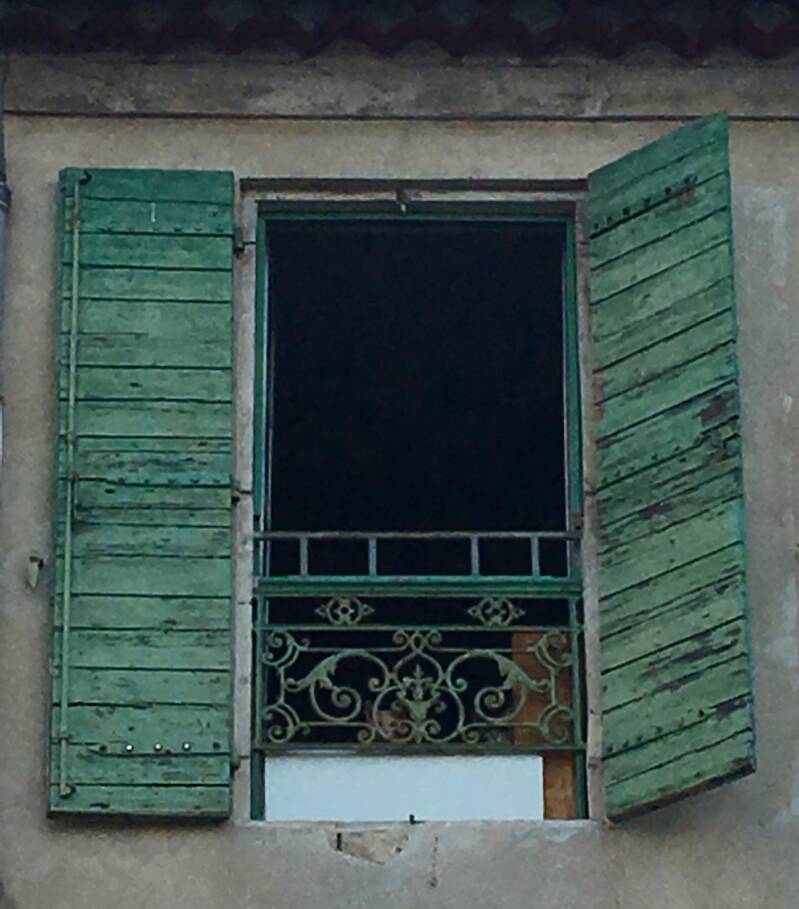

Cats in windows (look closely).
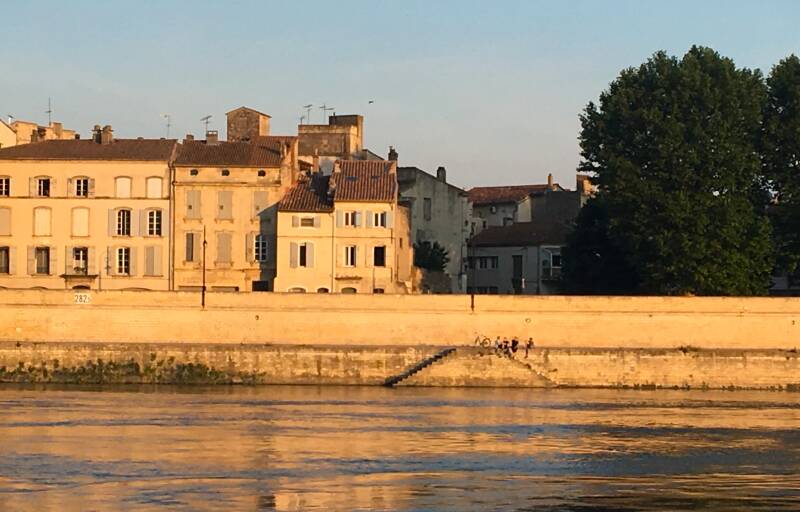
Golden Hour on the Rhone River.
After immersing ourselves in Arles’ museums, we wandered further through the old streets to see the city’s famous Roman monuments for ourselves. Standing inside the two-tiered Roman amphitheatre, built in 90 AD and once able to seat more than 20,000 spectators, felt astonishingly immediate—easy to imagine the roar of the crowds who came for chariot races and gladiator-style battles. These days it hosts bullfights (somewhat puzzling to us) as well as plays and concerts in summer.
Just a short stroll away, we reached the Roman Theatre of Arles, which actually predates the amphitheatre by about a century. Built at the end of the 1st century BC during the first wave of urbanisation after Caesar founded the colony in 46 BC, it was less well preserved but still impressive in scale. With traces of the ancient stage and a substantial lighting rig set up across the site, it was clear that modern concerts were being held here too—hard to picture now, but once it had welcomed around 10,000 spectators.
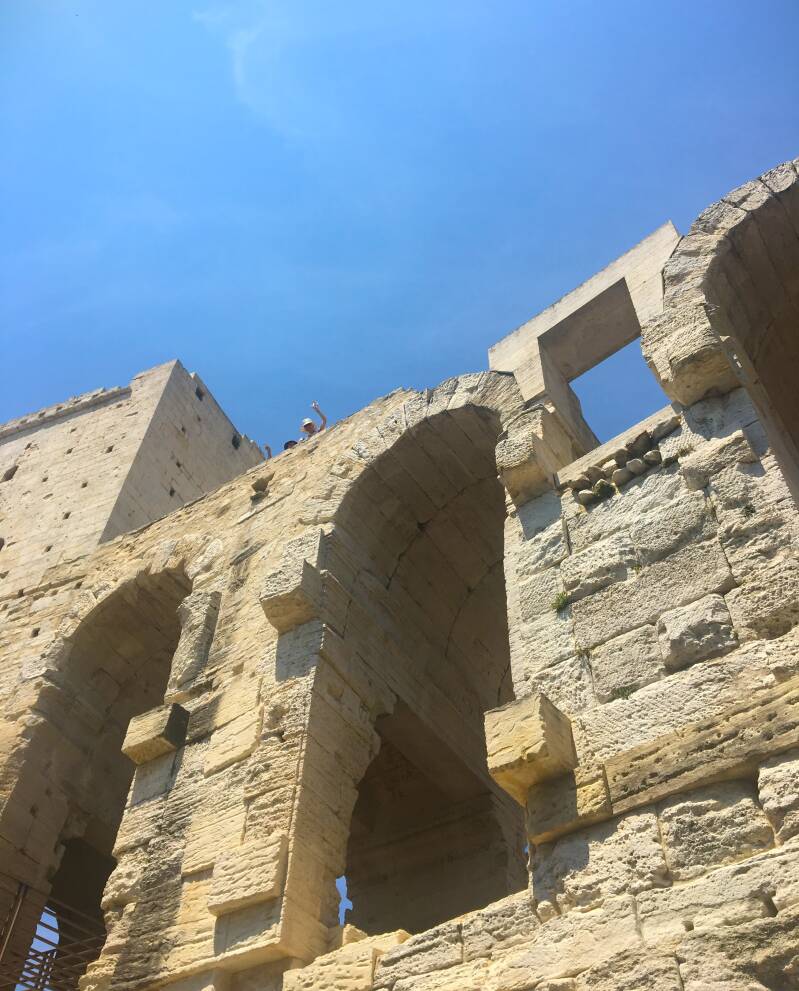
Look at me! Annie and Carol at the top of the amphitheatre.
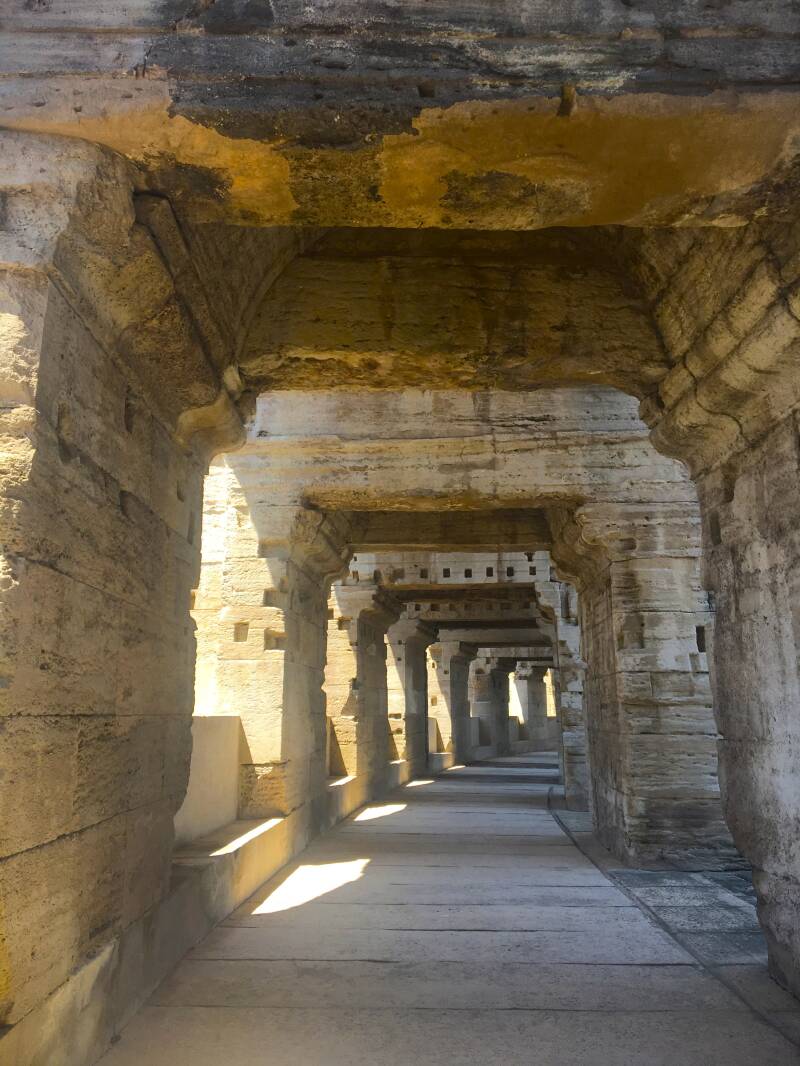
The cloisters of the amphitheatre.

Roman Theatre of Arles.
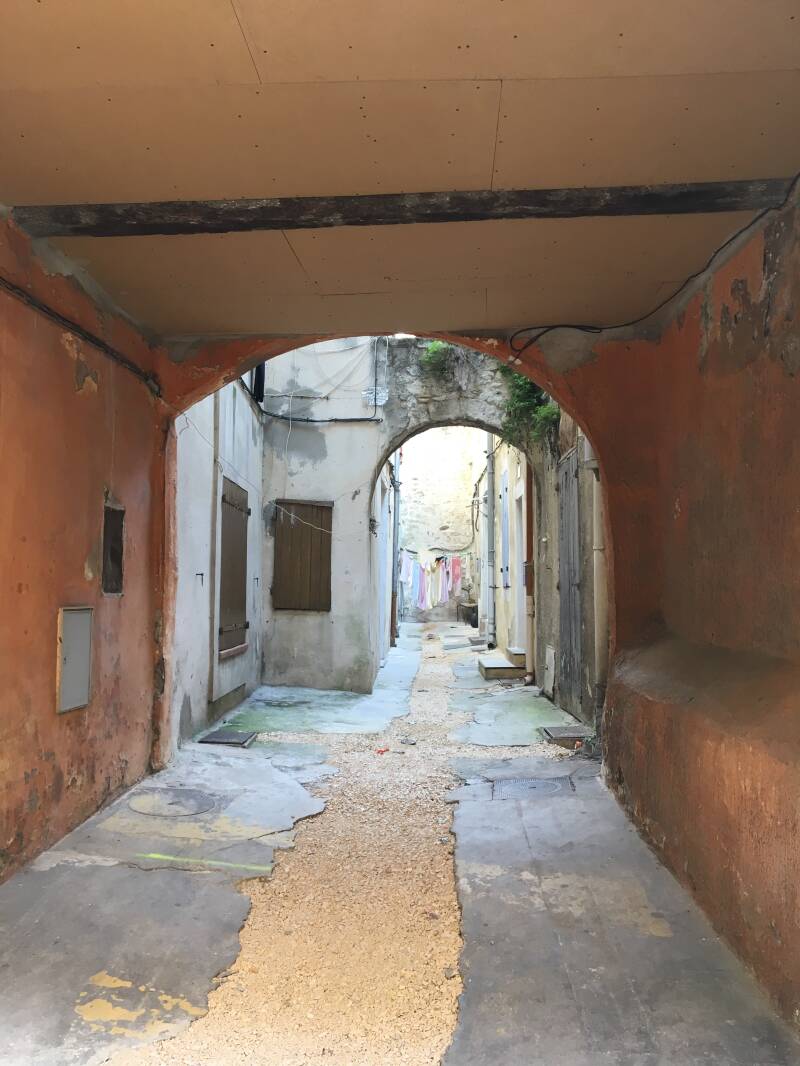
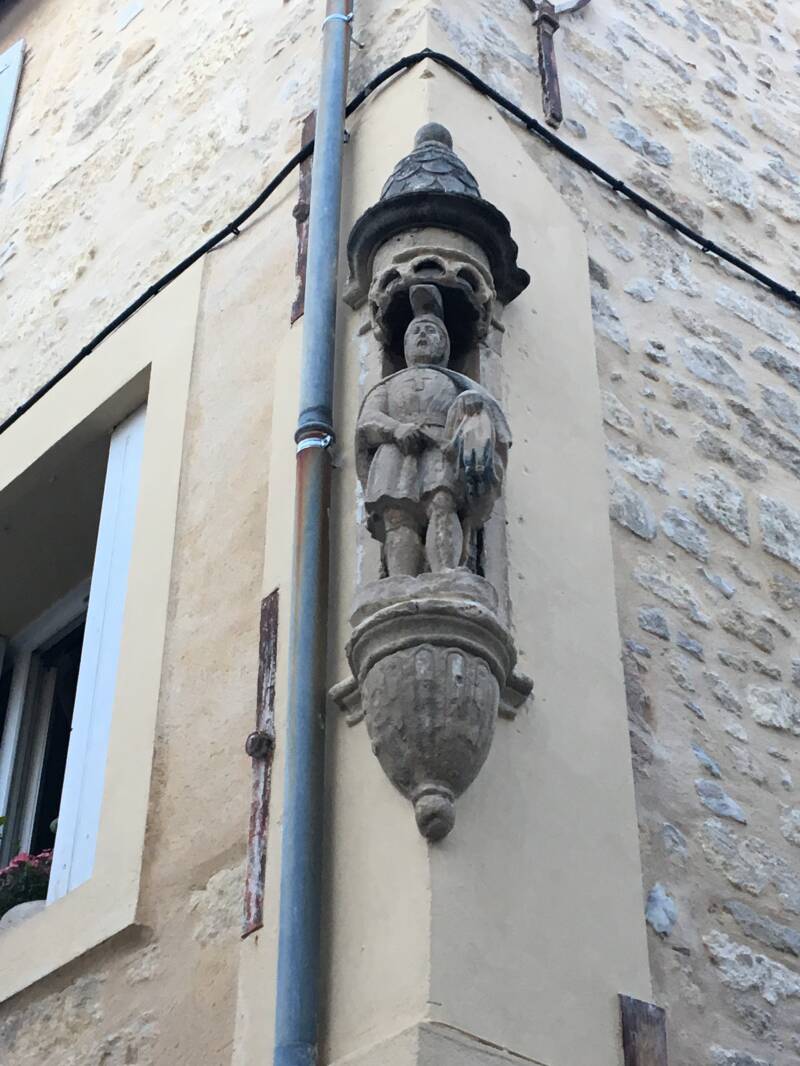
Plenty of texture in the laneways.


Maybe even a Banksy?

The gorgeous gardens and yellow buildings of Espace Van Gogh.
After checking out of our delightful Arles Airbnb we took one last cultural visit to Espace Van Gogh, the hospital where Vincent apparently had his ear stitched back on after that infamous incident. You can definitely see the inspiration for his paintings of the gardens there. For those of you not in the VG know, Vincent lived in Arles in the South of France for more than a year. He experienced great productivity there before suffering from a mental breakdown and produced many renowned paintings of the area such as the Yellow House, which he actually lived in. During this time he was joined by Gauguin and others; just imagine the creative climate!
On 8 May 1889, he left Arles to be voluntarily committed (although others tell me he was booted out as the locals had had enough of his lunacy) to a psychiatric institution in Saint-Rémy de Provence.
Unlike Vinnie, we left of our own free will and only because of the constraints of our crowded itinerary. This was the last day spent our hire car, without which we could not have explored many of the regions of France that we did; I think Annie and Carol didn't really want to part with it as they decided to take the 'creative' route, perhaps inspired by Vincent's madness, and we ended up on a bumpy road with views of factories - which I actually find interesting anyway.
After dropping our luggage off at the new airbnb which had the narrowest doorway I have ever experienced, they journeyed off to return the car whilst I walked to the Vasarely museum. As it was a Monday, not much in the way of museums was open so it was either walk 35 minutes up hills, over a highway and along a ghetto like road or nothing. The museum itself featured huge Vasareley paintings, tapestries and mosaics but was being expanded so it didn't really take long to experience it all.


Not sure what I am showing off here; we stopped for a coffee somewhere in Aix en Provence; selfie at the Vasarely museum.
By complete contrast, on the way home, I stumbled into The Pavillon de Vendôme, the surroundings of which were a complete contrast to the Vasarely Fondation, which resembled a building site in a remote location at the top of a hill. Reaching the Pavillion part of Vendôme required a pleasant stroll through formal French gardens with topiaried trees and seasonally planted flowers. As it was a long weekend, the public were out in force enjoying the ambience and warmth. Even some heavily armed young soldiers strolled through the garden, maybe to keep check on holiday revelers. My ICOM pass once again gave me access to the exhibitions inside the building (whereas it wasn't accepted at the Vasarely museum) and I was able to enjoy contemporary art within the 17th century interiors. Suitably the pavillion was built by an architect Pierre Pavillon (between 1665 and 1667). It was commissioned by for Louis, Duke of Vendôme (1612-1669) as a place where he could take his lover, Lucrèce de Forbin Solliès, also known as "la Belle du Canet". That's a lot of money invested in an affair!
Later, it was owned by the painter Jean-Baptiste van Loo (1684-1745), who had a studio there. It has also been owned by a Science academic, a Bishop who turned it into a Catholic boarding school for girls and a Swiss art collector, who donated it to the city.
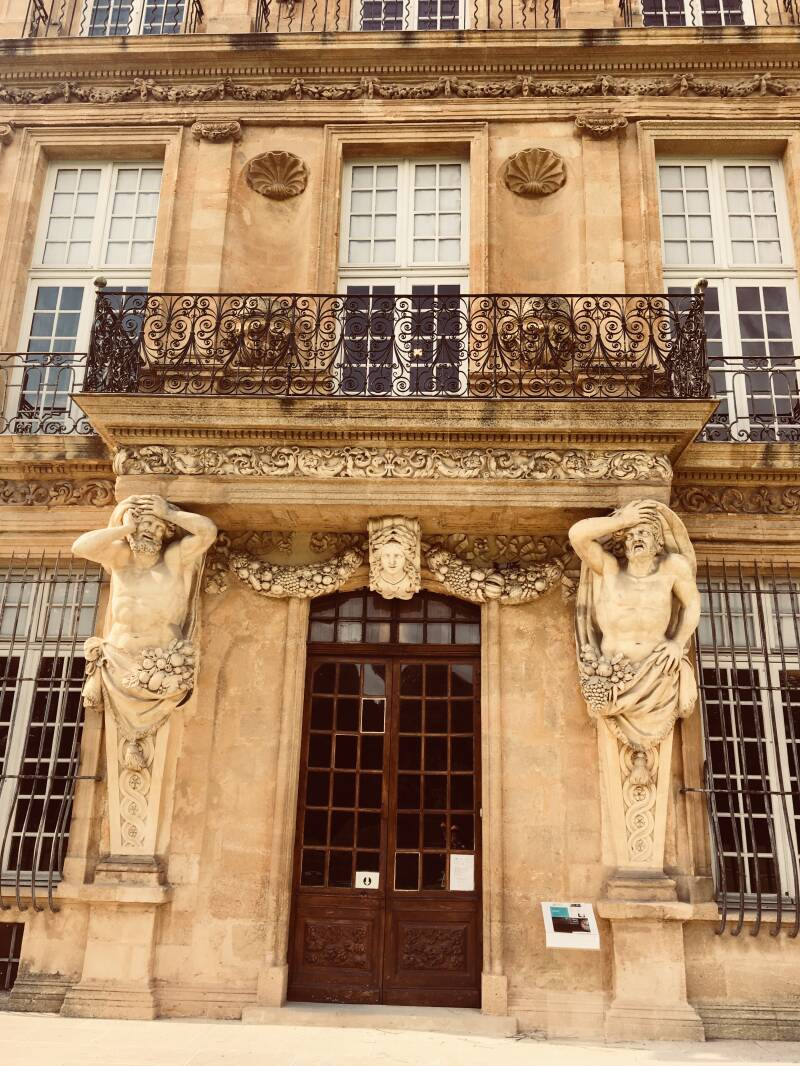
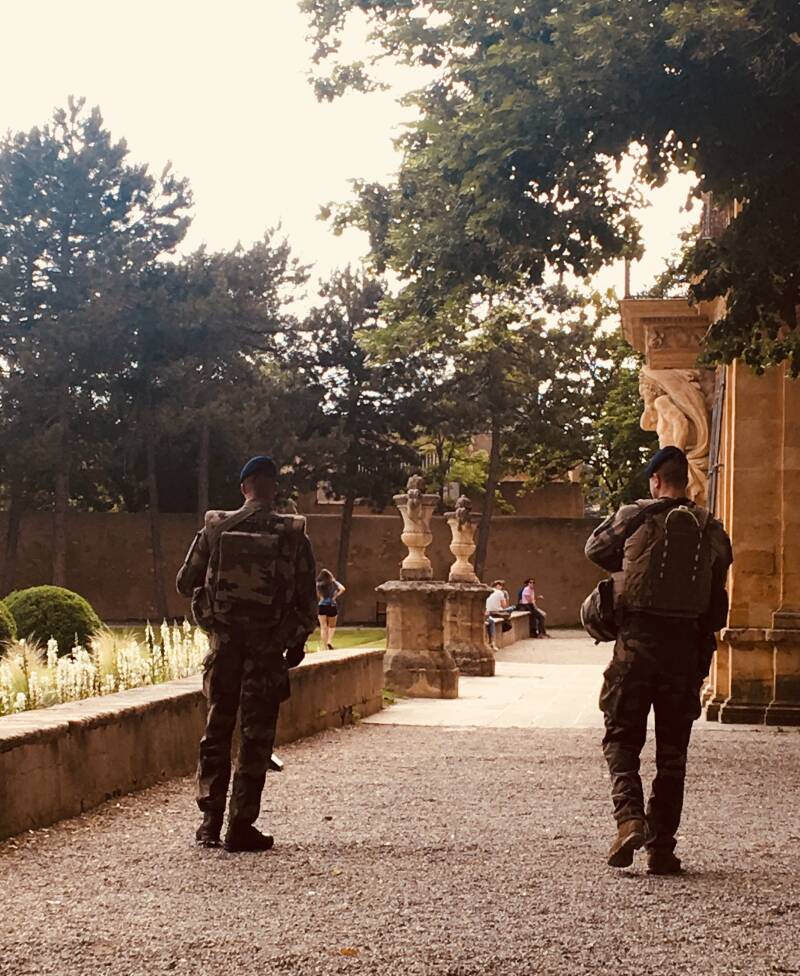
The intricate entrance to the The Pavillon de Vendôme and soldiers.


Art at the Aix-en-Provence cathedral.
Wandering through the old laneways of Arles, I was captivated by their texture, colour, and the way history seemed to cling to every corner. The Rhône glimmered in the distance, echoing the brushstrokes of Van Gogh, while Aix-en-Provence offered its own artistic surprises, from vibrant markets to echoes of Vasarely’s modernist vision. Between the streets, the art, and the riverside light, this part of Provence left me with a vivid palette of memories I’ll carry long after leaving.


Create Your Own Website With Webador